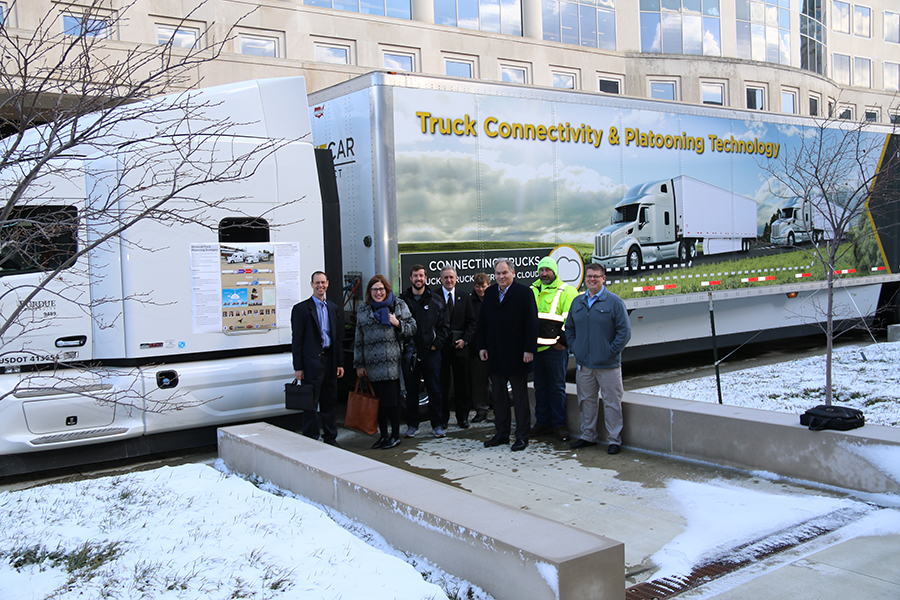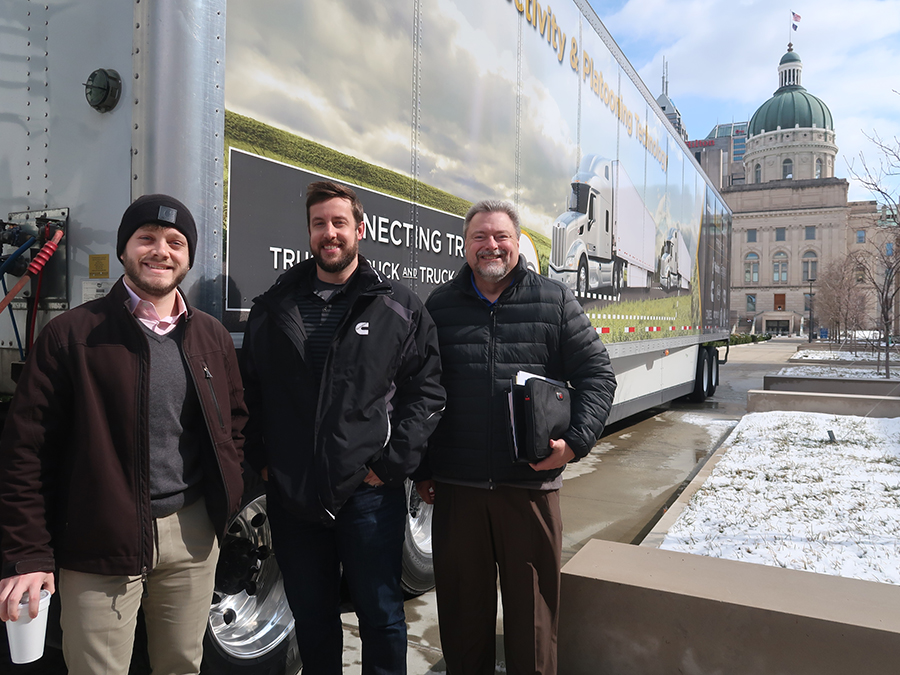Purdue Innovating Solutions To Boost Fuel Efficiency, Safety for Heavy-Duty Trucks
Purdue Engineering, Peloton Technology, and other industry partners - including Cummins and Peterbilt Motors - are collaborating to extend the benefits of two-truck platooning to hilly terrain, in a pioneering effort to improve fuel efficiency and safety.
Truck platooning uses wireless vehicle-to-vehicle (V2V) communications, active safety systems, automated braking and acceleration systems, and complex algorithms to enable pairs of semi-trucks to safely travel much closer together and to brake and accelerate in unison. This safety-linked grouping of trucks is called a truck platoon.
Most truck platooning systems being developed by OEMs and technology companies involve groupings of two or three trucks. Initial systems coming first to market limit platoons to two trucks at a time. In current two-truck platooning applications, both trucks have human drivers, but the driver of the rear truck only steers and monitors activity (just like in today’s widely used Cruise Control or Adaptive Cruise Control in cars and trucks) while the system controls the gap between the trucks. Automated following truck systems, which would cut trucking costs further, increase driver productivity, and address the growing professional truck driver shortage, are on the drawing board.

“Platooning in general reduces fuel consumption because the short distance between trucks takes advantage of decreased wind resistance for both the lead and follow truck,” says Greg Shaver, a Purdue professor of mechanical engineering and member of the Purdue Engineering Initiative in Autonomous and Connected Systems (PEI in ACS).
“By improving fuel economy, platooning reduces carbon and diesel emissions. In addition, accidents are less likely than with unaided driving, due to advanced active safety systems on both trucks and much faster reaction times for the automatically-assisted rear truck.”
The distance between platooned trucks is typically about 55 feet (roughly the average length of a semi-truck trailer), versus what truck driving manuals recommend for trucks without such technology – approximately 300 feet to 400 feet at typical highway speeds, depending on conditions. Of course, many conventional trucks on the road today follow much closer than 300 feet, despite the lack of active safety systems. The look-ahead active safety radar and automatic, synchronized braking of truck platoons enables the follow truck to respond almost instantly when the front truck slows or stops, or when other vehicles move unpredictably or traffic patterns change.
Extending Efficiencies
To date, Peloton, an industry innovator in trucking platooning, has primarily been operating its PlatoonPro system on relatively flat or lightly rolling highways, averaging more than 7 percent in fuel savings in customer trials.
As one key next step, the Purdue team has been working with Peloton to develop control strategies that enhance efficiencies of future platooning systems by extending truck platooning to hilly terrain. Shaver says this will expand opportunities to conserve fuel because it will increase the number of routes on which platooning can be implemented. Already, the team has achieved fuel reductions of as much as 15 percent in simulations.
“The strategies we are developing control how trucks move at highway speed by sending commands to the powertrain that regulate acceleration or braking power,” Shaver says. “Our tools and algorithms take into account the terrain, as well as weight and powertrain differences between the paired trucks, to determine optimal speeds and driving strategies.”
Industry partners are drawing on their technology expertise and real-world experience to guide the Purdue team’s work and ensure its commercial viability.
“In 2018, Peloton began hauling freight in coordination with multiple customer fleets to demonstrate the safety, fuel economy, and driver teamwork benefits associated with integrating platooning systems into fleet operations,” says Steve Boyd, Co-founder and Chief Executive Officer of Peloton Technology.
“We’re very excited about the innovative research work that Purdue is doing with us to help make platooning systems even more fuel-efficient and effective across a much wider range of routes in the U.S. Our partnership with Purdue helps build a stronger future for the commercial trucking industry, one that includes broader applicability of platooning to more routes, increased overall fuel savings and carbon emissions reductions, and better safety outcomes for all highway users.”
Advancing Awareness

Beyond its work based at the Ray W. Herrick Laboratories, the Purdue team is raising external awareness of the benefits of affordable, robust truck platooning to propel its commercial adoption.
“Our goals include helping fleet owners and managers make decisions about installing a platooning system, persuading truck manufacturers to offer platoon-enabling options, encouraging government leaders to pass enabling legislation if their states don’t have it (although the majority do), and receiving feedback from all these stakeholders,” Shaver says.
Efforts include participating in trade shows. For example, Shaver and other team members discussed and showed their innovations at the recent SAE COMVEC Technology Connection in Indianapolis. Shaver spoke on a panel on “disruptive technologies” for powertrains, and the team exhibited. Also, in conjunction with the event, the team had a static display of two PlatoonPro-capable, Cummins-powered Peterbilt trucks at the Indianapolis Motor Speedway.
“We generated substantial enthusiasm from industry leaders and policymakers,” Shaver says. “Our participation provided a chance to educate attendees about the advantages of expanding truck platooning and to answer their questions.”

Interdisciplinary Team
The Purdue project team combines diverse areas of expertise. Serving with Shaver are:
- Neera Jain, assistant professor of mechanical engineering
- Darcy Bullock, Lyles Family Professor of Civil Engineering, director of the Joint Transportation Research Program, and co-chair of the PEI in ACS
- Daniel DeLaurentis, professor of aeronautics and astronautics, director of the Institute for Global Security and Defense Innovation (i-GSDI), and member of the PEI in ACS
- Ryan Thayer, senior engineering technician in the School of Mechanical Engineering
- Graduate students Miles Droege, Brady Black, John Foster and Shubham Ashta
Q & A With Peloton Technology’s Steve Boyd

Steve Boyd, Co-founder and CEO of Peloton Technology, shared his thoughts on where truck platooning is heading and how Purdue is helping advance that progress.
What do you see as the future of truck platooning?
The future of driver-assistive truck platooning will be built upon today’s initial commercial platooning systems, which aim to improve highway safety, foster teamwork between professional drivers, and create new fuel economy gains and operational efficiencies for today’s commercial fleets.
The work that Purdue is doing in coordination with other industry partners will help achieve additional fuel economy benefits for hilly terrain through connectivity-enabled shift coordination and lead-truck predictive cruise.
Connected and automated vehicle technologies, like platooning, will also provide a significant foundation for the deployment of highly-automated truck solutions in the coming decade, beginning with new automated following systems like the AutoFollow system that Peloton is developing. Leveraging experience in deploying a commercial L1 platooning system, Peloton’s AutoFollow is an SAE Level 4 automated solution that connects a fully-automated following truck with a human driver-controlled lead truck. Initial versions of the system will have a single automated following truck, and later systems will allow for a human truck driver to lead a platoon of several automated following trucks.
At Peloton, we believe platooning will be a key enabler for the development and deployment of higher automation truck systems, bringing new opportunities to address the growing national highway safety crisis. By continuing to leverage a professional driver’s intuition and judgment through vehicle connectivity, AutoFollow’s path to deployment, operational effectiveness, and public acceptance will be faster and more widely scalable than standalone L4 truck solutions. The advanced solutions developed with our partners at Purdue can be applied to these next-generation platooning systems, expanding this system’s commercial viability to benefit new customers and cultivate new, more geographically diverse freight routes around the country.
Initial systems will have a single automated following truck, but future versions could allow for longer platoons of such trucks. A robust vehicle-to-vehicle communications link allows a human-driven lead truck to guide the steering, acceleration and braking of the follow truck and connects the active safety systems between the trucks. By keeping a human driver in the loop, this approach greatly simplifies many of the technical, operational and public acceptance challenges the vehicle automation industry is facing with deploying standalone driverless trucks. The two-truck AutoFollow system doubles driver productivity, allowing each driver to transport more freight, and helping to address the rapidly-growing professional truck driver shortage.
How has Purdue’s partnership with Peloton Technology helped to achieve more efficient platooning systems?
Peloton Technology is continually looking for new ways to innovate and add further cost savings opportunities for commercial fleets exploring truck platooning technology. The practical research that Purdue students, staff and faculty are pursuing is designed to expand the efficacy and profitability of deploying next-generation, driver-assistive platooning systems.
Purdue’s research aims to do this by allowing efficient use of truck platooning on a wider range of hilly/high-grade-change routes that might not have otherwise been practical for early-version platooning systems. This research is expected to lead to new and low-cost advanced truck platooning systems with improved fuel-efficiency capabilities – competitive advantages that platooning pioneers like Peloton are very interested in delivering to the marketplace.
Lower-cost, more-efficient platooning systems could also entice more fleets within the trucking industry to more rapidly adopt these systems – expanding the scale of improvements to highway safety, fuel consumption and CO2 emissions. These new fuel-economy improvement applications could also be applied to future automated following systems, which, in addition to boosting driver productivity, can deliver enhanced fuel efficiency.
Related Links
Greg Shaver - Faculty Spotlight
New York Times - How to Make Cars Cooperate
